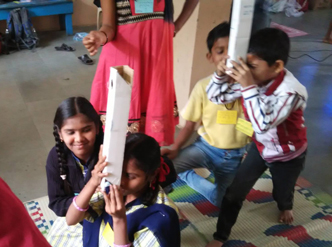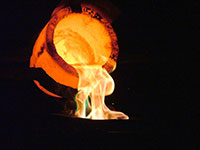Ten years: ten of our most popular articles Inspire article
Enjoy a nostalgic look back at some of your favourite articles from the Science in School archive.

gänseblümchen; image source;
Pixelio
While preparing this tenth birthday issue of Science in School, I spent several happy hours browsing through the journal archive, reminding myself of some of my favourite articles – those that had impressed me, fascinated me or made my fingers itch to try the activity myself. And then I looked at our online statistics to see which had been your favourites.
The most popular articles on the Science in School website cover the full range of our articles, including in-depth articles about recent discoveries, discussions of important science topics, simple hands-on activities for science lessons, more adventurous school science projects, and reviews of resources for the classroom. Our readers also appreciate the broad spectrum of target ages, ranging from materials for primary-school pupils to articles for pre-university school students. I was pleased to see that among the most popular articles were some of my personal favourites.
Understand
Unsurprisingly, our readers – mostly science teachers – are not put off by ‘hard’ science, including articles that present detailed explanations of scientific techniques or concepts.
Biology, Health
Ages 14-19
One of the most popular biology articles investigates the technique of genetic fingerprinting. In detective stories, the criminal is often identified by a drop of blood, a hair or other forensic evidence left at the scene. But how does this actually work? How was the technique of genetic fingerprinting developed? What else is it used for, and how can you try it in the classroom?
Müller S, Göllner-Heibült H (2012) Genetic fingerprinting: a look inside. Science in School 22: 49-56.
Biology, Chemistry
Ages 14-19
Did you know that another technique used by forensic scientists can make blood glow in the dark? Have you ever wondered what makes fireflies glow? Or those glow-in-the-dark sticks? Find out how chemiluminescence works, how common it is in nature and how it’s applied by humans.
Welsh E (2011) What is chemiluminescence? Science in School 19: 62-68.
For a hands-on activity about luminescence in biological organisms, see:
Farusi G, Watt S (2016) Living light: the chemistry of bioluminescence. Science in School 35: 30-36.
Biology, Physics
Ages 11-19
Talking of objects that shine in the dark, have you ever gazed up at the Moon and asked yourself what Earth would be like without it? Perhaps you should. Not only does the Moon affect the tidal movement of the oceans, the length of the days and the weather on Earth, but without the Moon, we might not even exist.
Tranfield E (2013) Life without the Moon: a scientific speculation. Science in School 26: 50-56.
Teach
Among the most-read articles were very simple hands-on experiments using everyday materials, but also more demanding activities requiring a little more preparation, such as sourcing material not usually found in the science department. Activities with an interdisciplinary aspect (for example, a link to history or music) also proved popular.

and Tim Saunders
Biology, Physics
Ages 14-19
Back in the 1600s, Robert Hooke built his first microscope. Today it’s surprisingly easy to build your own from simple materials – and then use it in the classroom to investigate the microscopic world around us.
Tsagliotis N (2012) Build your own microscope: following in Robert Hooke’s footsteps. Science in School 22: 29-35.
If you prefer something more challenging, you could even build your own digital microscope or atomic force microscope.
Singh AP et al. (2015) Doing is understanding: science fun in India. Science in School 34: 45-51.
Theer P, Rau M (2011) Single molecules under the microscope. Science in School 18: 60-64.
Biology, Chemistry, Physics
Ages 16-19
Staying at the microscopic scale, you could introduce your students to how the structure of proteins is used to investigate their function. Learn how proteins are crystallised and analysed using X-rays – and then grow your own protein crystals.
Blattmann B, Sticher P (2009) Growing crystals from protein. Science in School 11: 30-36.
Physics, Astronomy / space
Ages 11-19
If you prefer the larger scale, perhaps you’d like to build your own radio telescope? Astronomers use giant radio telescopes to observe black holes and distant galaxies, but a homemade radio telescope can be used to examine objects closer to home, including communication satellites and the Sun.
Malański B, Malański S (2012) Build your own radio telescope. Science in School 23: 38-42.
To learn more about how radio telescopes work, see:
Mignone C, Pierce-Price D (2010) The ALMA Observatory: the sky is only one step away. Science in School 15: 44-49.
Biology, Chemistry, General science, History
Ages 4-14
Radio telescopes may be a bit advanced for primary-school pupils, but more familiar objects – such as a loaf of bread – also offer a wide range of interdisciplinary teaching opportunities. Investigating micro-organisms, pretending you’re invading an unknown land, and making your own bread are just some of the ideas suggested in this article.
Lewis D (2012) Bread-making: teaching science in primary school. Science in School 23: 33-37.
Inspire
Science in School also publishes reviews of materials that are useful for teachers – such as books, websites or other resources. One of the most popular reviews was of science comics and cartoons. Often considered to be little more than a cheap pastime, they can in fact be very effective teaching materials.
Tatalovic M (2010) Science comics and cartoons. Science in School 14
Translations
From A for Albanian to U for Ukrainian, via Greek, French, Polish and Spanish: thanks to the efforts of our volunteer translators – over 200 scientists and teachers – you can read Science in School articles in 31 European languages.

into a cast to mae a gold
bar.
Image courtesy of The Puzzler;
image source: Flickr
Physics
Ages 4-14
Particularly popular among our Spanish-speaking readers was a collection of simple experiments to enable primary-school pupils to investigate what happens to solids, liquids and gases when we heat them.
Andersen E, Brown A (2012) El efecto del calor: experimentos sencillos con sólidos, líquidos y gases. Science in School 24
In English:
Andersen E, Brown A (2012) The effect of heat: simple experiments with solids, liquids and gases. Science in School 24: 23-28
Biology, Chemistry
Ages 14-19
Did you know that what you eat can affect your genes, making you more susceptible to diabetes, cardiovascular disease or obesity? Our diet influences not only our own health in this way, but can also affect that of our unborn children. This topic proved to be of particular interest to our Portuguese-speaking readers.
Florean C (2014) Alimentos que nos moldam: como a dieta pode mudar o nosso epigenoma. Science in School 28
In English:
Florean C (2014) Food that shapes you: how diet can change your epigenome. Science in School 28: 34-45
Is your favourite article available in your native language? Perhaps you’d like to join our team of volunteer translators and make it – or other articles – available to a wider readership.
How do you use our articles?
Web statistics can tell us how many people visit each page, how long they stay, and how they found our website – but they can’t tell us what we really want to know: how do you, our readers, use our articles? Which activities have you tried in the classroom? How did you adapt or extend them? Have any of our articles changed what you teach or how you teach it?
We’d love to hear from you, so do send your feedback to editor@scienceinschool.org or leave a comment at the end of this article.





